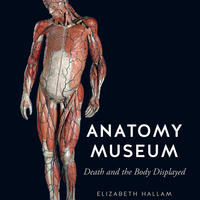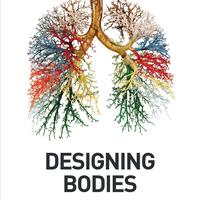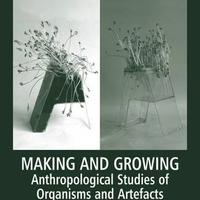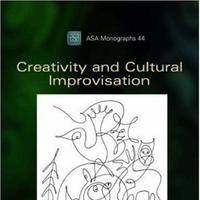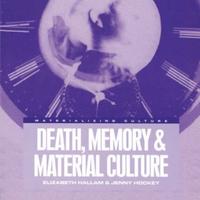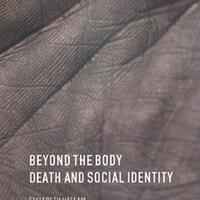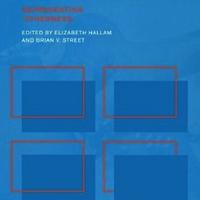Dr Elizabeth Hallam
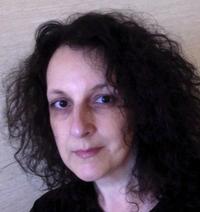
Associate Professor in Visual, Material and Museum Anthropology
Fellow of St Peter's College
Director of ISCA
Research Affiliate at the Pitt Rivers Museum, Oxford
Editorial Board member of:
My research and publications focus on the anthropology of the body; death and dying; material and visual cultures; human anatomy; three-dimensional models, especially in medical education; making and design; mixed-media sculpture; history and anthropology; experimental research with images and texts; fieldwork, archive and museum-based research mainly in the UK, along with recent multi-sited research begun in Australia, Singapore, and the USA.
I am currently developing collaborative museum, exhibition and installation projects, and a new strand of research on studios, spaces, and action in art practices and anthropology c.1960 to now.
Closely related to many areas of my research, my teaching is on the MSc and MPhil in Visual, Material, and Museum Anthropology.
Contact
Email: elizabeth.hallam@anthro.ox.ac.uk
My research and publications focus on the anthropology of the body; death and dying; material and visual cultures; human anatomy; three-dimensional models, especially in medical education; making and design; mixed-media sculpture; history and anthropology; experimental research with images and texts.
Following my earlier research on ritualised practices of childbirth, sickness and dying in early modern England, I developed my work on the body and death in two co-authored books, Beyond the Body: Death and Social Identity (with Glennys Howarth and Jenny Hockey), and Death, Memory and Material Culture (with Jenny Hockey). These books analyse death and memorialising as social and cultural processes, with reference to their bodily, material and visual aspects.
I have explored issues relating to material and visual culture in co-edited books including: Cultural Encounters: Representing ‘Otherness’ (with Brian Street) which examines visual, textual and museum representations; Creativity and Cultural Improvisation (with Tim Ingold) which addresses creative, material dynamics in social life and in practices such as writing, drawing and performing; and Making and Growing: Anthropological Studies of Organisms and Artefacts (with Tim Ingold) which investigates interrelations of growth and making, of decay and undoing, that give rise to and transform material entities, including human bodies.
My current research brings together my anthropological work on the body, death, material and visual culture, to focus on museums of anatomy in medical schools in Scotland and England. This research is concerned with the collection, preservation, display and uses of human bodies from the nineteenth century to the present. How and why bodies have been rendered in the flesh, in wax, paper and plastic, and through drawing, photography and film, in the pursuit of anatomical knowledge, are issues explored in my monograph, Anatomy Museum: Death and the Body Displayed (Reaktion), illustrated with specially commissioned photographs. This book won the Wellcome Medal for Anthropology as Applied to Medical Problems.
A further strand of this research examines three-dimensional models of human anatomy, c.1850 to the present, especially in terms of their design, making and use in medical education. This focuses on the social relations of models, their changing materials and forms, how they are created and disseminated, and the kinds of knowledge they generate. I have explored some these of issues as a guest curator of the exhibition Designing Bodies: Models of Human Anatomy from 1945 to Now, at the Royal College of Surgeons of England (2015-16, funded by the RCS and the Henry Moore Foundation), and in a co-edited book Medical Museums: Past, Present, Future (with Sam Alberti), which brings together work by curators, researchers, and photographers in Europe and the USA.
Drawing on this work, I am currently editing a book on 3D Modelling: Bodies and Buildings in Anthropology, Anatomy, and Architecture, to be published by Routledge.
Working with colleagues at the University of Melbourne since 2014, I am also a partner investigator on research projects, funded by the Australian Research Council, including ‘Disposal of the dead: beyond burial and cremation’, and ‘The Future Cemetery’. For further information please see the projects’ website.
Books and edited volumes
Anatomy Museum: Death and the Body Displayed (London: Reaktion Books, 2016). Awarded the Wellcome Medal for Anthropology as Applied to Medical Problems.
Designing Bodies: Models of Human Anatomy from Wax to Plastics, edited volume (London: Royal College of Surgeons of England, 2015).
Making and Growing: Anthropological Studies of Organisms and Artefacts, edited with Tim Ingold (Farnham: Ashgate, 2014).
Medical Museums: Past, Present, Future, edited with Samuel J.M.M. Alberti (London: Royal College of Surgeons of England, 2013). Published to celebrate the bicentenary of the Hunterian Museum at the Royal College of Surgeons of England.
Creativity and Cultural Improvisation, edited with Tim Ingold, ASA Monograph No. 44 (Oxford: Berg, 2007).
Death, Memory and Material Culture, co-authored with Jenny Hockey (London: Berg, 2001). Winner of the 2002 Katharine Briggs Folklore Award.
Cultural Encounters. Representing ‘Otherness', edited with Brian Street (London: Routledge, 2000).
Beyond the Body. Death and Social Identity, co-authored with Jenny Hockey and Glennys Howarth (London: Routledge, 1999).
Articles in books and journals
‘Object-spaces? Sensory engagements and museum experiments’, in P. Bjerregaard (Ed.) Exhibitions as Research: Experimental Methods in Museums, (London: Routledge, 2019), pp. 109-27.
‘Life in death’s residues’, (with Tamara Kohn), in Tamara Kohn, Martin Gibbs, Bjorn Nansen, Luke van Ryn (Eds) Residues of Death: Disposal Refigured, (London: Routledge, 2019), pp. 1-16.
‘Creativity and cultural improvisation ten years on: an update’ (Tim Ingold and Elizabeth Hallam), Portuguese translation, in Todas as Artes. Revista Luso-brasileira de Artes e Cultura (All the Arts. Luso-Brazilian Journal of Art and Culture), 2018, Vol. 1 (2): 135-41.
‘Creativity and cultural improvisation: an introduction’, (Tim Ingold and Elizabeth Hallam), Portuguese translation re-published from 2007, in Portuguese translation, in Todas as Artes. Revista Luso-brasileira de Artes e Cultura (All the Arts. Luso-Brazilian Journal of Art and Culture), 2018, Vol. 1 (2): 142-69.
‘The sensory aesthetics of death’ in H. MacDonald (Ed.) A Cultural History of Death in the Age of Empire, volume in ‘The Cultural History of Death’ series (London: Bloomsbury, in press).
‘Death and Digital Media: An Afterword’, in Michael Arnold, Martin Gibbs, Tamara Kohn, James Meese and Bjorn Nansen, Death and Digital Media (London: Routledge, 2017), pp. 141-56.
‘Relational anatomy: dissecting and memorialising the dead in medical education’, MAT Medicine Anthropology Theory, 23 October 2017, doi.org/10.17157/mat.4.4.314, special issue edited by B. Simpson and R. Douglas-Jones, New Immortalities.
‘Remembering as Cultural Process’, (with Jenny Hockey) in A.C.G.M Robben (Ed.) Death, Mourning and Burial: A Cross-Cultural Reader, 2nd Edition, (Oxford: Wiley-Blackwell, 2017), pp. 52- 63. Re-published from E. Hallam and J. Hockey, Death, Memory and Material Culture (Oxford: Berg, 2001).
'Bodies, materials, design: hands-on models in anatomy and surgery, 1920 to now', in E. Hallam (Ed.), Designing Bodies: Models of Human Anatomy from Wax to Plastics, (London: Royal College of Surgeons of England, 2015), pp. 4-43.
‘Anatomopeoia’, in E. Hallam and T. Ingold (Eds), Making and Growing: Anthropological studies of Organisms and Artefacts (Farnham: Ashgate, 2014), pp. 65-88.
‘Making and growing: an introduction’ (with Tim Ingold), in E. Hallam and T. Ingold (Eds) Making and Growing: Anthropological studies of Organisms and Artefacts (Farnham: Ashgate, 2014), pp. 1-24.
‘Anatomical design: making and using three-dimensional models of the human body’, in W. Gunn, T. Otto, R. C. Smith (Eds), Design Anthropology: Theory and practice (Oxford: Berg, 2013), pp. 100-116.
‘Disappearing Museums? Medical Collections at the University of Aberdeen’, in S.J.M.M. Alberti and E. Hallam (Eds), Medical Museums: past, present, future (London: Royal College of Surgeons of England, 2013), pp. 44-59.
‘Bodies in Museums’ (with Samuel J.M.M Alberti), in S.J.M.M. Alberti and E. Hallam (Eds) Medical Museums: past, present, future (London: Royal College of Surgeons of England, 2013), pp. 1-15.
‘Death, Diamonds, Paper and Plastic: two London exhibitions in 2012’, Mortality: Promoting interdisciplinary study of death and dying, 2013; 18(1): 98-103.
‘Articulating bones: an epilogue’, Journal of Material Culture, Special Issue on ‘The Substance of Bones’, edited by C. Krmpotich, J. Fontein and J. Harries, 2010; 15(4): 465-492.
‘Anatomists’ ways of seeing and knowing’, in W. Gunn (Ed.), Field notes and Sketchbooks: Challenging the Boundaries Between Descriptions and Processes of Describing (Hamburg: Peter Lang, 2009), pp. 69-107.
‘Anatomical Bodies and Materials of Memory’, in B. Brooks-Gordon, F. Ebtehaj, J. Herring, M. Johnson and M. Richards, on behalf of the Cambridge Socio-legal Group (Eds), Death Rites and Rights (Oxford: Hart Publishing, 2007), pp. 279-298.
‘Laboratoire anthropométrique. La fabrication du savoir sur le corps en Ecosse, de 1880 à 1930’ (‘Anthropometric Laboratory. Making knowledge of the body in Scotland, 1880-1930’), Ethnology française, Special Issue on ‘Anthropology at Home in Britain’, edited by S. Chevalier, J. Edwards and S. Macdonald, 2007 / 2 – April: 275-284.
‘Creativity and Cultural Improvisation: An Introduction’ (with Tim Ingold), in E. Hallam and T. Ingold (Eds) Creativity and Cultural Improvisation, ASA Monograph No. 44 (Oxford: Berg, 2007), pp. 1-24.
‘Anatomy display: Contemporary debates and collections in Scotland’, in A. Patrizio and D. Kemp (Eds), Anatomy Acts, (Edinburgh: Birlinn, 2006), pp. 119-135. Winner of The Royal Society of Medicine Library Prize for Medical Book of 2007.
‘Anatomy Museum. Anthropological and historical perspectives’, in A. Semedo and J. Teixeira Lopes (Eds), Museus, Discursos e Reresentações (Museums, Discourses and Representations) (Porto: Edições Afrontamento, 2005), pp. 111-134.
‘Speaking to reveal: The body and acts of exposure in early modern popular discourse’, in C. Richardson (Ed.), Clothing Culture, 1350-1650, (Aldershot: Ashgate, 2004), pp. 239-262.
'The eye and the hand: memory, identity and clairvoyants' narratives in England', in J. Campbell and J. Harbord (Eds), Temporalities, autobiography and everyday life (Manchester: Manchester University Press, 2002), pp. 169-192.
'The Body in Death' (with J. Hockey and G. Howarth), in N. Watson (Ed.), Reframing the Body (London: Palgrave Macmillan, 2001).
‘Texts, objects and “otherness”: problems of historical process in writing and displaying cultures’, in E. Hallam and B. Street (Eds), Cultural Encounters. Representing ‘Otherness’ (London: Routledge, 2000), pp. 260-283.
‘Introduction’ (with B. Street), in E. Hallam and B. Street (Eds), Cultural Encounters. Representing ‘Otherness’, (London: Routledge, 2000), pp. 1-11.
‘Death and the transformation of gender in image and text’, in D. Field, J. Hockey, and N. Small (Eds), Death, Gender and Ethnicity (London: Routledge, 1997), pp. 108-123.
‘Turning the hourglass: Gender relations at the deathbed in early modern Canterbury’, Mortality, 1996; 1(1): 61-82.
Communicating Otherness: Cultural Encounters, Exhibition catalogue, edited with Nicola Levell, (Published by the Graduate Research Centre in Culture and Communication, University of Sussex, 1996, ISBN: 1 900678 00 4).
I have a BA and PhD in Social Anthropology from the University of Kent, and was Lecturer in Social Anthropology at the University of Sussex (1994-96); Lecturer in Cultural History (1996-2001), Director of Cultural History (1998-2002) and Senior Lecturer in Social Anthropology (2002-10) at the University of Aberdeen. From 2010-19 I was a Research Associate in the School of Anthropology and Museum Ethnography, University of Oxford.

